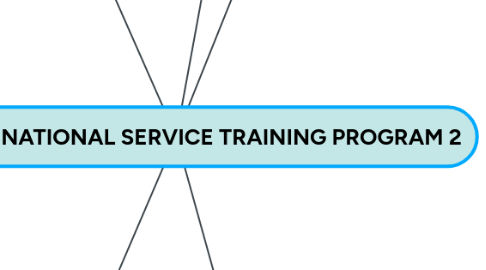
1. Disaster Risk Reduction Education
1.1. Philippine Hazard
1.1.1. Natural
1.1.1.1. Climate and Weather
1.1.1.1.1. Tropical Cyclone
1.1.1.2. Geophysical
1.1.1.2.1. Earthquake
1.1.1.2.2. Landslide
1.1.1.2.3. Tsunami
1.1.1.2.4. Volcanic erruption
1.1.2. Anthropogenic
1.1.2.1. Human Activities
1.1.2.1.1. Fire
1.1.2.1.2. Mining
1.1.2.1.3. Deforestation
1.1.3. Vulnerable
1.1.3.1. Pacific ring of fire
1.1.3.1.1. Earthquake
1.1.3.1.2. Tsunami
1.1.3.1.3. Volcanic hazards
1.1.3.2. Pacific Ocean (West)
1.1.3.2.1. Moonsons
1.1.3.2.2. Thunderstorms
1.1.3.2.3. El Niño
1.1.3.2.4. La Niña
1.1.3.2.5. ITCZ
1.1.3.2.6. Typhoons
1.1.3.3. Archipelagic Nature
1.1.3.3.1. Sea level changes
1.1.3.3.2. Tsunamis
2. Human Rights
2.1. Basic Principles
2.1.1. Universal
2.1.1.1. Sex
2.1.1.2. Religion
2.1.1.3. Class
2.1.1.4. Political belief
2.1.1.5. Social origin
2.1.2. Inherent
2.1.2.1. Inborn
2.1.2.1.1. Article 1
2.1.2.2. Birthright
2.1.3. Analienable
2.1.3.1. Can't be taken away
2.1.3.2. Lost
2.1.3.3. Surrendered
2.1.4. Indivisible
2.1.4.1. Co equal
2.1.4.2. Entitled
2.1.5. Non discriminatory
2.1.5.1. Equality
2.1.6. Interrelated and Interdependent
2.1.6.1. Mutually dependent
2.1.6.2. Reciprocal relation
2.1.7. Imprescriptible
2.1.7.1. No limit
2.1.7.2. No expiration
2.2. Dehumanization
2.2.1. Bias
2.2.2. Stereotyping
2.2.3. Prejudice
2.2.4. Discrimination
2.2.5. Violence
2.3. Individual
2.3.1. Political
2.3.2. Civil
2.3.3. Cultural
2.3.4. Social
2.3.5. Economic
2.3.5.1. Right to health
2.3.5.2. Right to social security
2.4. Collective
2.4.1. Right of society
2.4.1.1. Democracy
3. ENVIRONMENTAL EDUCATION
3.1. Republic Act 9003
3.1.1. National Environmental Awareness and Education Act of 2008
3.1.1.1. Integrate
3.1.1.1.1. School curricula (all levels)
3.1.1.1.2. Barangay day care
3.1.1.1.3. Preschool
3.1.1.1.4. Non formal
3.1.1.1.5. Technical vocational
3.1.1.1.6. Professional level
3.1.1.1.7. Out of school youth
3.1.1.1.8. Indigenous
3.1.1.1.9. New Topic
3.1.1.1.10. Courses
3.1.1.1.11. Program
3.1.2. Ecological Solid Waste Management Act of 2000
3.1.2.1. Prohibited Acts
3.1.2.1.1. Littering
3.1.2.1.2. Non segregated waste
3.1.2.1.3. Operation dumps
3.1.2.2. Classification of waste
3.1.2.2.1. Compostable
3.1.2.2.2. Recyclable
3.1.2.2.3. Residual
3.1.2.2.4. Special
3.1.2.3. Three R's
3.1.2.3.1. Reduce
3.1.2.3.2. Reuse
3.1.2.3.3. Recycle
3.2. Republic Act 9152
3.2.1. Enviromental Awareness and Education
3.2.1.1. Education about the environment
3.2.1.2. Education in the environment
3.2.1.3. Education for the environment
3.2.2. December 12, 2008
3.3. XU's Initiative
3.3.1. Green Campus Agenda
3.3.1.1. Green Cleaning Agents
3.3.1.2. Materials Recovery Facility (MRF)
3.3.1.3. Composting and vermicomposting facility
3.3.1.4. Biopori
3.3.1.5. Waste management program
4. USE OF ILLEGAL DRUGS
4.1. RA 9165
4.1.1. Social
4.1.2. Economic
4.1.3. Political
4.2. Rehab Program
4.2.1. Section 54, Article 8
4.2.2. Section 77, Article 9
4.2.3. Section 2, Article IX
4.3. PDEA
4.3.1. SUPPLY REDUCTION
4.3.1.1. Drug groups
4.3.1.1.1. Arrest
4.3.1.1.2. Neutralize
4.3.1.1.3. Dismantling
4.3.1.1.4. Destruction of dangerous drugs
4.3.2. DEMAND REDUCTION
4.3.2.1. Drug Dependents
4.3.2.1.1. Rehabilitation
4.3.2.1.2. Referral for treatment
4.3.2.1.3. Anti drug lectures
4.3.2.1.4. Seminar
5. Gender Development
5.1. Sex
5.1.1. Biological
5.1.2. Predetermined
5.1.3. Universal
5.1.4. Natural
5.2. Gender
5.2.1. Cultural/Social
5.2.2. Taught/Nurtured
5.2.3. Impermanent
5.2.4. Time bound/Place bound
5.3. Gender Bias
5.3.1. Marginalization(economic)
5.3.1.1. Media
5.3.1.2. Popular Culture
5.3.1.2.1. Manipulation
5.3.2. Violence Against Women
5.3.2.1. Sexual harassment
5.3.2.2. Rape
5.3.2.3. Cat calling
5.3.2.4. Sexual passes
5.3.2.4.1. "Hokage" moves
5.3.2.5. Domestic voilence
5.3.2.5.1. Battered wife
5.3.2.6. Commodification
5.3.2.6.1. Use as sex object
5.3.3. Subordination
5.3.3.1. Inequality
5.3.3.2. Few women are in politics
5.3.3.3. inferior gender
5.3.3.4. New Topic
5.3.4. Multiple Burden
5.3.4.1. Parenting
5.3.4.2. Housework
5.3.4.3. Community work
5.3.4.4. Informal sector
5.3.5. Gender Stereotyping
5.3.5.1. Religion
5.3.5.2. Occupation
5.3.5.3. Education
5.3.5.4. Language
5.3.5.5. Behavior
5.3.5.6. Government programs
5.4. GENDER FAIR SOCIETY
5.4.1. Vision
5.4.1.1. Marginalization
5.4.1.1.1. Pay for equal work
5.4.1.1.2. Economic independence
5.4.1.1.3. Economic equality
5.4.1.2. Subordination
5.4.1.2.1. Recognition of capabilities
5.4.1.2.2. Quality participation(decision making)
5.4.1.3. Multiple burden
5.4.1.3.1. Shared parenting
5.4.1.3.2. Shared housework
5.4.1.4. Stereotyping
5.4.1.4.1. Liberation from stereotyped images
5.4.1.4.2. Non-sexist child rearing
5.4.1.4.3. Non-sexist language
5.4.1.5. Violence Against women
5.4.1.5.1. Freedom from violence
5.4.1.5.2. Freedom from harassment
5.4.1.6. Personal
5.4.1.6.1. Personhood development
5.4.1.6.2. Control over one's body

